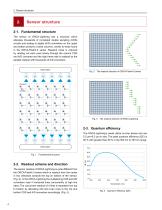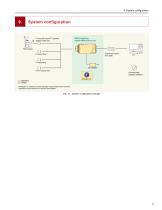
Catalog excerpts

Technical note June 2019 ORCA-Lightning Digital CMOS camera C14120-20P HAMAMATSU
Open the catalog to page 1
Table of contents Introduction ······································· P2 1. Specifications ································ P3 2. Sensor structure ····························· P4 2-1. Fundamental structure 2-2. Readout scheme and direction 2-3. Quantum efficiency 3. Sensor size ···································· P5 3-1. Field of view 3-2. Pixel size 3-3. Camera mounts 4. Readout modes ······························ P6 4-1. Normal Area Mode 4-2. Lightsheet Readout Mode Sensor and interface speeds Frame rates at Normal Area Mode Frame rates at Lightsheet Readout Mode How to compare...
Open the catalog to page 2
1 Typical value *2 Setting range of 4H: 12.608 ps to 200 ps *3 Setting range of 4H: 50.432 ps to 200 ps
Open the catalog to page 3
Sensor structure Data output
Open the catalog to page 4
Sensor size The sensor of the ORCA-Lightning has 4608 pixels horizontally and 2592 pixels vertically, for a total of approximately 12 megapixels. Given that the pixel size is 5.5 μm, the field of view (FOV) is 25.3 mm horizontally and 14.3 mm vertically with a resultant 29.0 mm diagonal. The pixel size of ORCA-Lightning is 5.5 μm and unique among large array CMOS cameras (greater than 10 megapixels) which typically have much smaller pixels. This pixel size allows for high signal to noise ratio, low magnification imaging (for instance with a macro lens). Because the ORCA-Lightning FOV is...
Open the catalog to page 5
Readout modes 4-1. Normal Area Mode The ORCA-Lightning employs a rolling shutter readout which reads the rows from top to the bottom. The area readout mode can operate in “normal readout mode” or “normal shutter readout mode”. The time span between readouts becomes the exposure time in normal readout mode. Because 4 rows are readout concurrently as described in section 2-2 the start of the exposure of each set of 4 concurretnly read rows are shifted accordingly. 4 horizontal lines are read concurrently. Frame interval Normal readout Readout time Vertical lines time Exposure Frame N Normal...
Open the catalog to page 6
4-2. Lightsheet Readout Mode Lightsheet Readout Mode in the ORCA-Lightning is a method synchronizing the exposure position of the pixel rows to the position and speed of the excitation light beam. When the excitation light beam scan is slow it can be synchronized by delaying the readout timing of the rows (Fig. 8). In Lightsheet Readout Mode the exposure time of the camera is relative to the illumination slit width. While shortening the exposure time makes the slit width more narrow and removes scattered light caused by diffraction, it also can result in fewer photons available to the...
Open the catalog to page 7
5. Maximum frame rates Maximum frame rates 5-1. Sensor and interface speeds The maximum possible full frame output data rate of the ORCA-Lightning sensor is larger than any current (as of this writing) computer interface can accommodate. The ORCA-Lightning is provided with a CoaXPress-6*4 lane interface which allows for acquisition of full frame rates of 121 frames/s in Standard Full Well Capacity (hereinafter referred to as FWC) mode. By using the camera in sub-array mode the number of pixels that must be transferred becomes fewer and the maximum sensor data rate becomes slower than the...
Open the catalog to page 8
6. Dark current and cooling 5-4. How to compare ORCA-Lightning frame rates to other cameras. As an example Fig. 14 shows a speed comparison of the ORCA-Flash4.0 and ORCA-Lightning in normal readout, light sheet readout mode and pixel rates. The frame rate varies by the number of pixels in the sub-array used. In order to compare the absolute speed of the ORCA-Lightning to other cameras you should be certain each camera is outputting frames with the same number of pixels. Frames per second ORCA-Flash4.0, C-mount (2048×2048) ORCA-Lightning, C-mount Dark current and cooling The sensor...
Open the catalog to page 9
Dimensional outlines 7-1. Adjustable support poles Adjustable support poles are available as an option for the ORCA-Lightning when using the side port of a microscope. Adjustable pole for C14120-20P (2 pieces) A14490-01 Fig. 15 Adjustable support poles 7-2. Tripod mount plate An optional tripod mount plate is available for the ORCA-Lightning with a 1/4 inch, 20 TPI (Threads per inch). Base plate for C14120-20P A14491-01
Open the catalog to page 10
System configuration ORCA-Lightning Digital CMOS camera set F-mount/C-mount TV camera adapter relay lens Microscope CoaxPress board and cable C-mount lens F-mount lens AC adapter TFL-II mount lens Commercially available software HCImage Live* Standard Option * HCImage Live software provides standard image measurement functions. Upgrades to more feature-rich versions are available. Fig. 17 System configuration example
Open the catalog to page 11
ORCA is registered trademark of Hamamatsu Photonics K.K. (France, Germany, Japan, U.K., U.S.A.) Product and software package names noted in this documentation are trademarks or registered trademarks of their respective manufacturers. Subject to local technical requirements and regulations, availability of products included in this promotional material may vary. Please consult your local sales representative. Information furnished by HAMAMATSU is believed to be reliable. However, no responsibility is assumed for possible inaccuracies or omissions. Specifications and external appearance are...
Open the catalog to page 12All Hamamatsu Photonics France catalogs and technical brochures
-
ORCA-spark
2 Pages
-
ORCA-Fusion
28 Pages
-
ORCA Lightning
8 Pages
-
BT-CCD camera C8000-30
2 Pages
-
X-ray TDI camera C12300-321
4 Pages
-
TDI camera C10000-801
2 Pages








